Bradypus pygmaeus
| Pygmy three-toed sloth | |
|---|---|
 |
|
| 1825 illustration, Thomas Landseer | |
| Scientific classification | |
| Kingdom: | Animalia |
| Phylum: | Chordata |
| Class: | Mammalia |
| Order: | Pilosa |
| Family: | Bradypodidae |
| Genus: | Bradypus |
| Species: | B. pygmaeus |
| Binomial name | |
|
Bradypus pygmaeus Anderson & Handley, 2001 |
|
 |
|
| Range of the pygmy three-toed sloth | |
The pygmy three-toed sloth (Bradypus pygmaeus), also known as the monk sloth or dwarf sloth, is a sloth endemic to Isla Escudo de Veraguas, a small island off the coast of Panama. The species was first described by Robert P. Anderson of the University of Kansas and Charles O. Handley Jr., of the Smithsonian Institution in 2001. The pygmy three-toed sloth is significantly smaller than the other three members of its genus, but otherwise resembles the brown-throated three-toed sloth. According to Anderson and Handley Jr., the head-and-body length is between 48 and 53 centimetres (19 and 21 in), and the body mass ranges from 2.5 to 3.5 kg (5.5 to 7.7 lb).
This sloth, like other sloths, is arboreal (tree-living) and feeds on leaves. It is symbiotically associated with green algae, that can provide it with a camouflage. Details of mating behavior and reproduction have not been documented. The pygmy three-toed sloth is found exclusively in the red mangroves of Isla Escudos de Veraguas, restricted to an area of 4.3 square kilometres (1.7 sq mi). A 2012 census of pygmy three-toed sloths estimated the total population at 79. The IUCN lists the pygmy three-toed sloth as critically endangered and they are listed on the world's 100 most threatened species.
The pygmy three-toed sloth was first described by Robert P. Anderson of the University of Kansas and Charles O. Handley Jr., of the Smithsonian Institution in 2001. The researchers noted that the three-toed sloths endemic to Isla Escudo de Veraguas, a small island off the coast of Panama, are significantly smaller than those that occur on the nearby outer islands of Bocas del Toro Province. Moreover, they differ from other populations in terms of pelage and cranial characteristics. Hence, they considered the three-toed sloths in Isla Escudo de Veraguas to be an independent species and formally described it from the skin and skull of an adult female. The researchers further pointed out that Isla Escudos de Veraguas is the oldest island and located farthest from the mainland, that began breaking up into small islands due to rises in sea levels 10,000 years ago. They proposed that this species evolved from an isolated population that had originated from the mainland population of brown-throated three-toed sloths; it gradually differentiated enough to become an independent species through insular dwarfism. In another study the following year, the researchers observed that the mean body size of three-toed sloths on an island decreases linearly as the age of the island increases; the area of the island and the distance from the mainland, however, do not appear to significantly affect dwarfing.
...
Wikipedia

